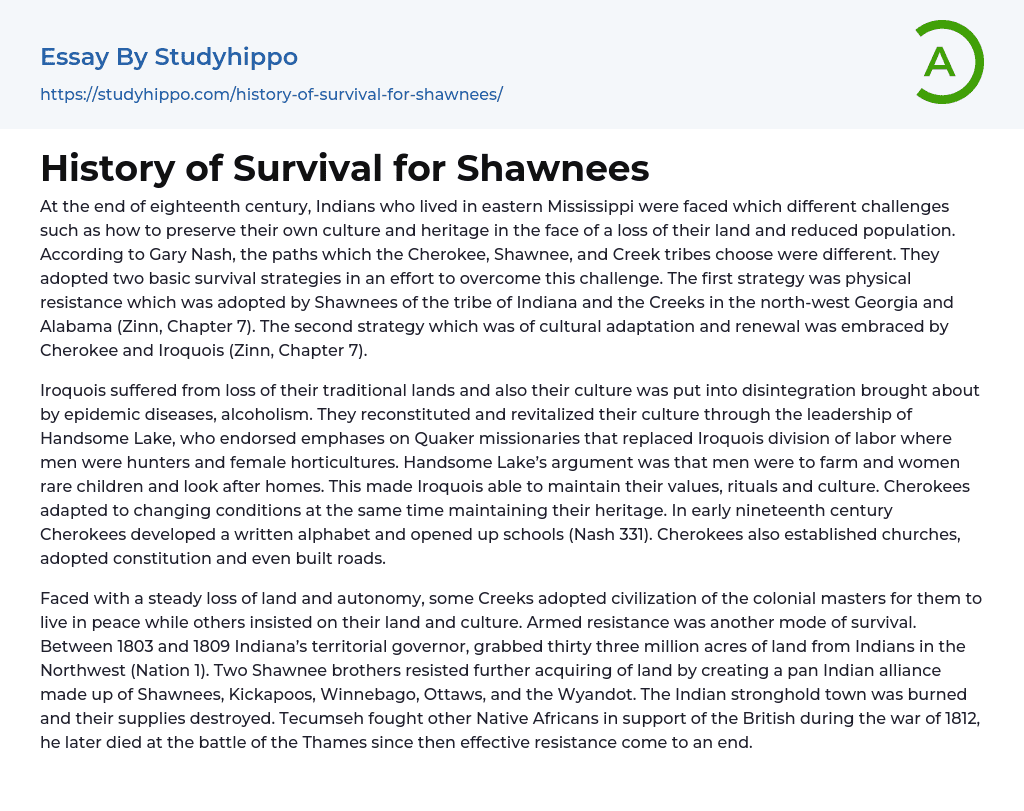During the late 18th century, Native Americans residing in eastern Mississippi encountered various challenges. One of these challenges involved preserving their culture and heritage despite the loss of their land and dwindling population. Gary Nash notes that the Cherokee, Shawnee, and Creek tribes each took different paths to address this situation.
They adopted two basic survival strategies in an effort to overcome this challenge. The first strategy, which was physical resistance, was adopted by the Shawnees in Indiana and the Creeks in the northwest parts of Georgia and Alabama, as mentioned in Zinn's Chapter 7. The second strategy, which involved cultural adaptation and renewal, was embraced by the Cherokee and Iroquois tribes, also discussed in Zinn's Chapter 7. The Iroquois faced the loss of their traditional lands and the disintegration of their culture due to epidemic diseases and alcoholism. However, they
...were able to reconstitute and revitalize their culture under the leadership of Handsome Lake. He emphasized the importance of Quaker missionaries, who replaced the Iroquois division of labor that assigned men as hunters and women as horticulturists.
Handsome Lake argued that men should be responsible for farming while women should care for children and maintain homes. According to Handsome Lake, this division of labor allowed the Iroquois to preserve their values, rituals, and culture. Similarly, the Cherokees managed to adapt to changing conditions while also preserving their heritage. In the early nineteenth century, the Cherokees even created a written alphabet and established schools (Nash 331).
Cherokees, just like Creeks, took various measures to adapt to the changing times and preserve their way of life. This included establishing churches, adopting a constitution, and constructing roads. However, as they
faced the constant loss of land and independence, some Creeks chose to embrace the ways of the colonial masters in order to live in peace, while others vehemently defended their land and culture. Engaging in armed resistance became a means of survival for many Native Americans. An example of this occurred between 1803 and 1809 when Indiana’s territorial governor seized a staggering thirty-three million acres of Indian land in the Northwest (Nation 1).
Two Shawnee brothers, Tecumseh and his brother Tenskwatawa, opposed further land acquisition and formed a unified alliance with other Native American tribes including the Kickapoos, Winnebago, Ottawas, and Wyandots. Unfortunately, their Indian stronghold town was destroyed, and their supplies were extinguished. Tecumseh fought alongside the British in the war of 1812 against other Native Americans but met his demise at the battle of the Thames. Since then, effective resistance against land acquisition came to an end.
- Administration essays
- Architect essays
- Discipline essays
- Doctor essays
- Engineer essays
- Farmer essays
- Hunter essays
- Labor essays
- Model essays
- Nurse essays
- Pilot essays
- Police Officer essays
- Professionalism essays
- Social Work essays
- Stakeholders essays
- Teamwork essays
- American Culture essays
- Car Culture essays
- Cultural Differences essays
- Culture Shock essays
- Different Cultures essays
- Indian Culture essays
- Mexican Culture essays
- Mormon essays
- Pop Culture essays
- Popular Culture essays




